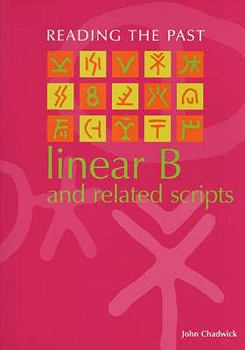Book Overview
An introductory guide to the script, its decipherment and its significance.
Format:Paperback
Language:English
ISBN:0714180688
ISBN13:9780714180687
Release Date:December 1987
Publisher:British Museum Press
Length:64 Pages
Weight:0.40 lbs.
Related Subjects
Alphabet Ancient Education & Reference Foreign Language Foreign Language Dictionaries & Thesauruses Foreign Language Fiction Foreign Language Learning Foreign Language Study Foreign Language Study & Reference Foreign Languages History Humanities Instruction Language Arts Linguistics Social Science Social Sciences Words, Language & GrammarCustomer Reviews
2 ratings
It's not quite Greek to me...
Published by Thriftbooks.com User , 21 years ago
John Chadwick's book on Linear B and related scripts (part of the 'Reading the Past' series put out by the British Museum in cooperation with the University of California Press) is an excellent primer to the subject of this ancient language. Like the other texts in this series, the book itself is only 64 pages long, which makes the task of learning an ancient language like Linear B, an ancient proto-Greek script, less daunting. Do not be deceived by the low number of pages - there is a wealth of material here.This is, strictly speaking, not a book from which one learns the language as much as it is a primer to learn about the language, with a little technical and translation information thrown in for good measure. In the course of such a short book, however well written, one could not expect otherwise. However, the depth of material is impressive given the limited number of pages.In the first chapter, Chadwick deals with the history of the discovery of Linear B. He talks of Schleimann's Troy expeditions, and the various nineteenth century discoveries and excavations around Turkey, Greece and Crete that enabled the archaeologists to uncover civilisations long forgotten, seemingly even by their successors, the ancient Greeks and other Aegeans. The second chapter describes the process of initial decipherment, covering both basic ideas in solving such a puzzle, as well as a bit of narrative history relating the people involved. The deciphering of Linear B is a relatively recent enterprise, coming to fruition really in the middle of the twentieth century. Linear B's syllabary, consisting of letter/syllable signs, ideograms, and numerals, consists of 87 signs (by contrast, modern English really consists of 26 letters and 10 numerals; however, the real count changes if one considers combinations like SH and TH to be unique signs, and that the letter C can be hard like a K or soft like an S).Even so, Chadwick in the third and fourth chapters shows the difficulty of writing with Linear B script, the problems that possibly made this language impractical for writing extended narratives and histories (such as survive from cuneiform and Egyptian hieroglyph languages); Linear B's record comes to us in the form of records kept by administrators, rather than histories, liturgies and literatures produced by scholars, scribes and artists. Similarly, the volume of Linear B tablets and writing surviving is painfully small by comparison. However, as deficient as scholars are in artifacts and surviving remnants of Linear B, the case is even worse for Linear A, not to mention the even older pictographic script of Crete preceding Linear A. Linear A is probably derived from the older script; Linear B is probably derivative of Linear A, but not in any clearly discerned way. Attempts at deciphering Linear A continue, which include looking at non-Greek parallels (is Linear A in fact the writing of a Semitic language?). Chadwick concludes by looking at the possi
How to read Linear B
Published by Thriftbooks.com User , 23 years ago
Having just read Simon Singh's brilliant book on codes, which has a brilliant chapter on the decipherment of the ancient Cretan language known as Linear B, I wanted to read further about it. This is as far as I have got so far and its a pretty easy second step. John Chadwick is of course the man who assisted Vestris to decipher this ancient language and perhaps that is why Singh's chapter on how the language was initially 'cracked' is so much more interesting than the chapter Chadwick provides on it. Chadwick determindly doesn't blow his own trumpet, in fact he almost glosses over some of the stages which Singh emphasises. Still it is a reasonable telling of it and Singh clearly drew heavily on Chadwick's own examples for his chapter.Chadwick starts to get interesting in the later chapters where he examines the form of Linear B in far greater depth - how it was used and the sounds and its relationship to the ancient Greek language. He also discusses the advances which have been in made in deciphering the older, and as yet not fully understood writing, also found on Crete and called "Linear A". It is a short, pithy book, but a good further step for those interested in reading more on these languages but with no technical training in the subject (like me) - an enthusiastic amateur.






